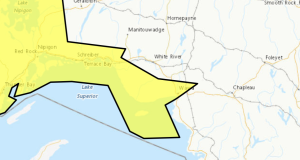Dec 15, 2019 at 15:55
Lake Superior and Lake Michigan-Huron remain near record-highs for this time of year, but are expected to continue their seasonal declines in December. As a result, there will continue to be a significantly increased risk of shoreline erosion, lakeshore flooding and coastal damages over the next several weeks and potentially through the winter. The International Lake Superior Board of Control (Board) advises all those that may be affected to prepare for potentially severe coastal impacts, especially during periods of strong winds and high waves.
Lake Superior declined 8 cm over the course of the month, while on average the water level declines 5 cm in November. At the beginning of December, Lake Superior is 9 cm below the record-high beginning-of-month level set in 1985. The level is currently 33 cm above average (1918 – 2018) and 6 cm above its level of a year ago.
Lake Michigan-Huron declined 2 cm over the course of the month, while on average the water level declines 4 cm in November. Lake Michigan-Huron is currently 5 cm below the record-high beginning-of-month level set in 1986. The level is 90 cm above average, and 42 cm above last year’s beginning-of-December level.
The Board recently received approval from the International Joint Commission to continue to deviate from Lake Superior Regulation Plan 2012 through this winter. A small amount of additional flow will be released through the St. Marys Rapids this winter to offset expected and potential unscheduled reductions in flows at the hydropower plants that often occur in challenging winter conditions. This will be achieved by maintaining a gate setting equivalent to one gate fully open over the winter months instead of the typical winter setting equivalent to one-half gate open.
Gates are typically maintained at a constant setting in winter to avoid issues with ice, including the potential for ice jams in the St. Marys River. Additionally, the higher rapids flows from December through April provide an increase in wetted habitat for fish that have already spawned in the rapids or that may over-winter in this area. It is anticipated that this deviation will have a minimal impact on Lake Superior and Lake Michigan-Huron water levels.
In consideration of the above, the Board expects the total outflow to be 2520 m3/s in December, which is 110 m3/s more than that prescribed by Lake Superior Regulation Plan 2012. Actual outflows may vary depending on hydrologic and ice conditions, as well as maintenance activities or other unexpected outages at the hydropower plants on the St. Marys River. The gate setting at the Compensating Works was adjusted on 5 December. Gates #5 through #12 will be maintained at a setting of 26 cm open (equivalent to one gate fully open) through the winter months. There will be no change to the setting of Gate #1, which supplies a flow of about 15 m3/s to the channel north of the Fishery Remedial Dike.
SOURCE – International Lake Superior Board of Control
- Letter to Doug Ford – Another Devastating Tragedy on Northern Ontario Highway - December 23, 2025
- NAPS lay charges in historic child abuse investigation - December 23, 2025
- Federal Offender arrested in Timmins - December 23, 2025
 Wawa-news.com You can't hear the 'big picture'!
Wawa-news.com You can't hear the 'big picture'!

